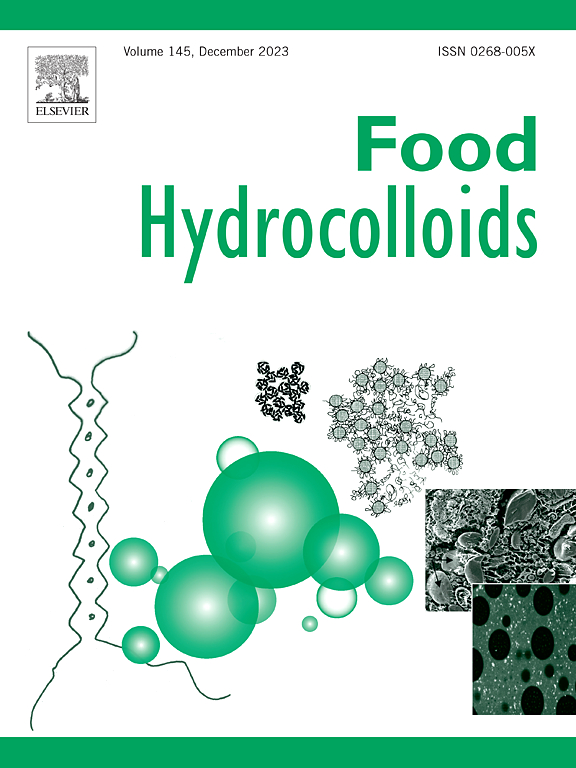Regulation of disulfide bond cleavage on the physicochemical and digestive properties of EGCG-gluten covalent complexes
IF 11
1区 农林科学
Q1 CHEMISTRY, APPLIED
引用次数: 0
Abstract
Disulfide bond critically govern gluten structure and its covalent interactions with polyphenols, ultimately determining gluten-polyphenol complex properties. This study investigated how disulfide bond cleavage modulates gluten structure, enhances epigallocatechin gallate (EGCG)-gluten covalent binding, and regulates the physicochemical/digestive properties of their complexes. Sodium metabisulfite treatment (0–25 mM treatment) induced disulfide bonds cleavage, which promoted the structural unfolding and exposed reactive groups for covalent binding with EGCG. With analysis of particle size, fluorescence spectroscopy, fourier-transform infrared spectroscopy, and thermogravimetric analysis, disulfide bond cleavage significantly reduced the particle size (from 124.5 to 62.26 μm) of gluten, altered the secondary (α-helix decreased from 23.4 % to 15.1 %, β-sheet from 32.8 % to 23.7 %) and tertiary structures of gluten, increased its surface hydrophobicity and enhanced its binding efficiency (from 51.98 % to 62.02 %) with EGCG. With increase of disulfide bond cleavage, EGCG-gluten covalent complexes exhibited enhanced thermal, pH, and oxidation stability, along with strong antioxidant activity. In addition, the disulfide bond cleavage of gluten inhibited the premature releasing and degradation of EGCG from covalent complexes during the digestion process, which was beneficial for improving the bioaccessibility of EGCG. All results suggest that the disulfide bond cleavage of gluten improve the physicochemical and digestive properties of EGCG-gluten covalent complexes, which provides a potential approach to regulate the properties of proteins-polyphenols covalent complexes as delivery systems of active compounds for functional foods and nutraceuticals.

二硫键裂解对蛋鸡-谷蛋白共价配合物理化和消化特性的调控
二硫键关键控制谷蛋白结构及其与多酚的共价相互作用,最终决定谷蛋白-多酚复合物的性质。本研究探讨了二硫键断裂如何调节面筋结构,增强表没食子儿茶素没食子酸酯(EGCG)-面筋共价结合,并调节其复合物的物理化学/消化特性。焦亚硫酸钠处理(0 ~ 25 mM)诱导二硫键断裂,促进结构展开,暴露出与EGCG共价结合的活性基团。通过对面筋粒径、荧光光谱、傅里叶变换红外光谱和热重分析发现,二硫键的裂解使面筋粒径从124.5 μm减小到62.26 μm,二级结构(α-螺旋结构从23.4%降低到15.1%,β-片结构从32.8%降低到23.7%)和三级结构发生改变,表面疏水性增强,与EGCG的结合效率从51.98%提高到62.02%。随着二硫键劈裂的增加,鸡蛋cg -面筋共价配合物表现出增强的热稳定性、pH稳定性和氧化稳定性,并具有较强的抗氧化活性。此外,谷蛋白的二硫键断裂抑制了EGCG在消化过程中从共价复合物中过早释放和降解,这有利于提高EGCG的生物可及性。上述结果表明,蛋白二硫键的断裂改善了蛋白-谷蛋白共价复合物的物理化学和消化性能,为调节蛋白-多酚共价复合物作为功能食品和营养保健品中活性化合物的传递系统的性能提供了一种潜在的途径。
本文章由计算机程序翻译,如有差异,请以英文原文为准。
求助全文
约1分钟内获得全文
求助全文
来源期刊

Food Hydrocolloids
工程技术-食品科技
CiteScore
19.90
自引率
14.00%
发文量
871
审稿时长
37 days
期刊介绍:
Food Hydrocolloids publishes original and innovative research focused on the characterization, functional properties, and applications of hydrocolloid materials used in food products. These hydrocolloids, defined as polysaccharides and proteins of commercial importance, are added to control aspects such as texture, stability, rheology, and sensory properties. The research's primary emphasis should be on the hydrocolloids themselves, with thorough descriptions of their source, nature, and physicochemical characteristics. Manuscripts are expected to clearly outline specific aims and objectives, include a fundamental discussion of research findings at the molecular level, and address the significance of the results. Studies on hydrocolloids in complex formulations should concentrate on their overall properties and mechanisms of action, while simple formulation development studies may not be considered for publication.
The main areas of interest are:
-Chemical and physicochemical characterisation
Thermal properties including glass transitions and conformational changes-
Rheological properties including viscosity, viscoelastic properties and gelation behaviour-
The influence on organoleptic properties-
Interfacial properties including stabilisation of dispersions, emulsions and foams-
Film forming properties with application to edible films and active packaging-
Encapsulation and controlled release of active compounds-
The influence on health including their role as dietary fibre-
Manipulation of hydrocolloid structure and functionality through chemical, biochemical and physical processes-
New hydrocolloids and hydrocolloid sources of commercial potential.
The Journal also publishes Review articles that provide an overview of the latest developments in topics of specific interest to researchers in this field of activity.
 求助内容:
求助内容: 应助结果提醒方式:
应助结果提醒方式:


